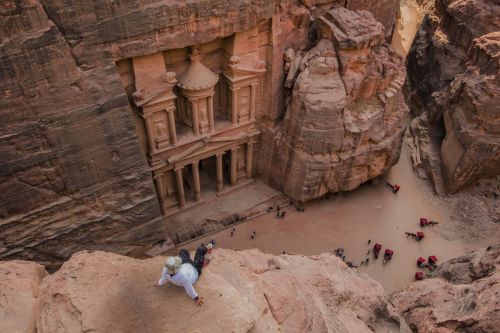She lived at the turn of the fourth and fifth centuries. She embodied the ideal of the ancient scholar. Hypatia was a mathematician and a well-trained philosopher who studied algebra, geometry and astronomy.
She is credited with inventing the first tools for determining the position of the stars in the sky. She was called "the last pagan", but her lectures were attended by Christians and pagans alike, not only from Alexandria and Egypt, but from Syria, Cilicia and Constantinople.
She died at the hands of the Christians in such a cruel way that she was called a pagan martyr.
She was probably born around 355 or 370. Such dates are given in her biographies, written by ancient scholars decades after her death. Most modern scholars believe that Hypatia was born in 370.
Alexandria was a wealthy and multinational city where the Greeks had a lot to say as well as the Egyptians. It was also home to the largest Jewish colony outside the land of Israel.
In ancient and medieval times, Alexandria was a centre of cultural life, its importance being given by some of the greatest centres of learning of the time: the Musaeon - the Temple of the Muses, which housed the treasures of Greek literature, cared for by scholars who sought to preserve them for future generations, and the Great Library of Alexandria, which was part of it. The library attracted the greatest figures in the world of scholarship at the time - its collection could hold some 700,000 rolls of papyrus, an impressive number for the time.
Within the city there was also the island of Pharos, on which there was a lighthouse that is now considered to be one of the Seven Wonders of the World.
Theon was an active scholar, he is known to have observed the solar eclipse that took place in Alexandria on 16 June 364 and the lunar eclipse on 25 November of the same year.
He was the author of commentaries on the Almagest (the Arabs' distorted name for Claudius Ptolemy's work, which is the greatest monument of astronomical knowledge) and on Ptolemy's astronomical tables, describing their use and construction.
His greatest work was the compilation of a version of the The Elements (a geometric and arithmetic treatise from the late 4th century BC, written by Euclid), which until the end of the 19th century was the only known Greek text of this book. It is also known that Theon compiled a list of Roman consuls up to the year 372.
Theon was the last director of the Library of Alexandria, which was closed in 391 by order of the Emperor Theodosius.
Together with her father, she worked on the edition of Euclid's Elements and commentaries on the works of Ptolemy - most likely their final form, which has survived to the present day, is her work. She worked on commentaries and editions of Diofantos' 'Arithmetic' and Apollonius of Pergia's 'Cones'. Theon believed that his daughter surpassed him in mathematical knowledge and vision. She is said to have been fascinated by conic sections (ellipse, hyperbola and parabola).
Some scholars believe that Hypatia was educated in Athens, but it is more likely that she never left Alexandria while gaining knowledge and working with her father. She soon reached a level that allowed her to become a figure of distinction among her scholarly contemporaries.
An astrolabe is an instrument used to determine the position of celestial bodies above the horizon. It was used in astronomy and navigation until the early 18th century, when the sextant was invented. The astrolabe was used by Nicolaus Copernicus, among others.
An areometer is an instrument used to determine the relative density of liquids without the need for complex measurements and mathematical calculations.
From about 400 she was the head of the Platonic School in Alexandria. She taught mathematics, philosophy and astronomy. Hypatia gathered around her a circle of devoted students who formed a community seeking knowledge and understanding of the nature of reality based on Pythagorean-Platonic philosophy.
She demanded of herself and her students effort of mind, will and sacrifice, but at the same time she was a tolerant person with an open view of philosophical problems.
Hypatia came from an aristocratic background and circulated among the ruling and cultural elite. Her students were well-born and influential, but the school was open to Christians, pagans and followers of other religions.
Hypatia made no distinction between pagan and Christian students. After graduating from the school, they held high positions in Alexandrian society. One of Hypatia's most famous pupils was Synesius of Cyrene, who became Bishop of Ptolemais in Libya in 410. In this way she undoubtedly left her mark - more or less directly - on Alexandrian life.
She also gave public lectures on mathematics and astronomy in her house and in the lecture halls of the city. Her eloquence, modesty and beauty, combined with her extraordinary intellectual qualities, attracted many listeners to her lectures, not only from Alexandria, but also from Cyrenaica, Syria or Constantinople. Students from Egypt were also present.
During her carriage rides through the city, she often stopped at public institutions and spoke to officials and dignitaries, including the imperial prefect Orestes.
Some believed that she was held in high esteem by the whole city. The Suda Lexicon (a 10th century Byzantine lexicon of some 30,000 entries) records: "In her words eloquent and logical, in her deeds prudent and noble... The city welcomed her with dignity and gave her the respect she deserved".
Her knowledge and experience were put to good use and she was often consulted on important decisions concerning the running of the city. One of her friends wrote: "She knew how to speak wisely even to the representatives of authority and did not need to be ashamed when she appeared among men; everyone not only respected her for her unusual prudence, but even felt intimidated by her".
She was known for her extraordinary beauty, but devoted her entire life to science. Hypatia had an uncompromising view of the relationship between men and women, which she expressed in sometimes controversial ways.
Pierre Chuvin (French Hellenist and historian) quotes the following anecdote: "To an audience member who had fallen in love with her, she is said to have shown her sanitary towel and said: 'That's what you've fallen in love with, young man, and it's not pretty!' Her behaviour indicated that she was at least as proud of her virginity as a Christian nun.
Hypatia lived during the spread of the Christian faith, but remained a pagan (non-practising) herself. She respected anti-pagan legislation, did not visit temples and did not take part in protests against the demolition of pagan temples or their conversion into Christian churches. Despite her paganism, she maintained contacts with imperial and municipal officials, most of whom were Christians.
The situation changed in 412 when Theophilus' nephew, Cyril of Alexandria, ascended the episcopal throne. His orthodox reign began, full of religious demonstrations, doctrinal conflicts and interference in public affairs.
He envied the mathematician's wisdom and extensive astronomical knowledge, but above all her popularity with the Alexandrian people. He wanted to be the leader of the Alexandrian community, but Hypatia had already taken her place among the elite.
This fuelled his ambition and led to frustration and pathological envy. Cyril's followers and himself launched a smear campaign against the scholar. Rumours were spread of her secret powers (sorcery) and satanic influence over the imperial governor Orestes and the whole city.
In March 415, a mob of Christians led by the church lector Peter, whom Socrates described as a fanatic, kidnapped Hypatia as she was returning home in a carriage. She was then dragged in front of the Church of the Caesareum and stripped. Her body was wounded and skinned alive with ostracons, shells and tiles. After the brutal murder, the woman's body was insulted by being cut into pieces and burned in a place called Kinaron.
The investigation into the mathematician's death even reached the imperial court.
The Irish philosopher and freethinker from the Rationalist movement, John Toland, an advocate for victims of religious persecution, interpreted her death in an anti-Catholic spirit in his treatise Hypatia or the History of a most beautiful, most virtuous, most learned and in every way accomplished lady, who was torn to pieces by the clergy of Alexandria to gratify the pride, emulation and cruelty of the archbishop commonly but undeservedly titled St Cyril.
Hypatia was reborn as an icon of the struggle between reason and religion, knowledge and ignorance.
In 2015, her name crossed the borders of the solar system. An exoplanet discovered in 2002 orbiting the star Edasich (Jota Draconis) was named after the scientist. The planet's name was proposed by the 'Hypatia' student group at the University of Madrid.













